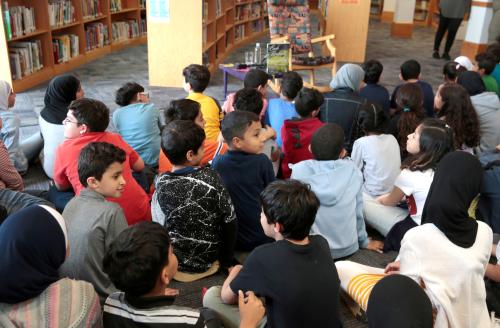Math and reading scores on the 2022 National Assessment of Educational Progress—known as “the nation’s report card”—raised widespread concern when they were released last fall. Just as troubling, however, is news that the average 8th grade proficiency rates in civics and U.S. history fell to 1998 levels, or only 22% and 13% proficient, respectively.
This finding is especially important in light of our country’s changing demographics. Today’s classrooms include nearly 14 million Latino students, representing more than a quarter of our K-12 public school students. Young people are more likely to engage and achieve when they learn about the accomplishments of people like themselves. They are also more likely to understand others when they encounter diverse narratives and perspectives. A new report suggests that we have a long way to go there, too.
Our institutions—UnidosUS, the nation’s largest Latino civil rights organization, and the Johns Hopkins Institute for Education Policy, a leading research and policy center—recently released a report documenting Latino representation in six commonly used U.S. history high school textbooks. We reviewed each book, cover to cover, searching for specific content (people, places, and events) that had been deemed seminal to the Latino story by scholars in the field. There were two criteria for inclusion in the list: first and foremost, historical significance; second, ethnic diversity, since Latinos are connected to more than twenty countries. The resulting list included 10 broad content areas, such as “Texas Independence and the Mexican-American War (1836-1848),” or “Hispanic/Latino Firsts (from 1821 to the present),” each of which included relevant knowledge topics, such as the Battle of Buena Vista and General Samuel Houston, or Ellen Ochoa, the first Hispanic woman astronaut in space, respectively. The study included 222 knowledge topics across all 10 content areas.
Our rubric for review included the gateway question: Is this specific knowledge topic present in the textbook with respect to the Hispanic experience? Yes or no?” If “yes,” our team evaluated the books’ presentation of the topic according to five measures: (1) Content, or the extent to which the source builds meaningful background knowledge; (2) Language, or whether the text conveys the topic in well-written, engaging prose; (3) Balance, or the source’s appropriate balance of the contributions of Latinos and the barriers they faced; (4) Authenticity, or whether the sources represent the authentic voices and experiences of this community; and (5) Universal Questions, or whether the account connects students to deeper questions about the human condition, a just society, or democratic citizenship. Each was scored on a scale from one to three.
We found a few good signs, but many more missed opportunities.
Textbooks cover few important knowledge topics, and rarely in depth
In the aggregate (i.e., across all textbooks), none of the seminal content areas was covered in depth, as summarized in Table 1. Seminal Content 8: U.S. Purchases and Foreign Policy in Latin America came the closest, at 1.4 out of three. Furthermore, the balance between oppression and contributions leaned heavily towards the former, except where Latino participation and leadership in 20th century civil and legal rights pertained.
At the more granular level of knowledge topics, only 13% of the identified ones were mentioned with any depth in all six textbooks. For instance, in Seminal Content 8: U.S. Purchases and Foreign Policy in Latin America, six knowledge topics (out of 21) were covered in depth across all textbooks. However, in Seminal Content 1: Spanish Exploration, Conquest, and Colonization, only two (out of 22) knowledge topics were covered in depth—and in Seminal Contents 5 (20th Century Latino Legal Cases) and 9 ( Hispanic/Latino Firsts), not one knowledge topic was covered in depth in all six books.
Put differently, across all 222 important topics, only 28 were covered with more than perfunctory detail. This means that high school students using these textbooks learn very little about Latino contributions to the legal developments that shaped the Voting Rights and Civil Rights Acts; details of the Panama Canal and the Mexican-American War or the Spanish-American War and their aftermaths; or why Lyndon Johnson declared Hispanic Heritage Week in 1968. Indeed, the only Latino breakthrough moment across 200 years that all six textbooks cover was Justice Sonia Sotomayor’s appointment to the Supreme Court.
As far as connecting the dots between specific events (e.g., the Voting Rights Act of 1965) and perennial questions about human dignity and a just society (e.g., who has membership in a democratic society?), only the AP textbook did so consistently. The AP textbook explicitly raised questions about the uncomfortable juxtaposition between U.S. democratic freedoms for a select few (white, male), and enslavement or conquest for others. Three of the books offered some opportunities for deeper reflection in some seminal content areas. The two remaining books were intellectually and emotionally flat, and our teams found a lack of depth and few opportunities for classroom deliberation and debate. The absence of engaging context is tragic, because among other things an “open classroom climate,” characterized by discussion about important topics and multiple perspectives, is linked in the research to positive civic outcomes.
Textbook language and authenticity vary
The above balance and universal questions are related, in different ways, to the writing style and the presentation of Latino primary sources. We found variability in the Language and Authenticity scores, as well, as shown in Table 2.
On the positive side, the AP U.S. History textbook was, by far, the best-written in terms of strong verbs, complex sentence structure, and engaging copy (scoring almost a perfect three out of three). This applied even when a topic was not given much space in the text. We wish all students—not only those in advanced classes—encountered such strong writing on a daily basis.
In their presentation of literary and visual primary sources and modern-day graphics that spoke to the Latino narrative, some books offered both quantity and quality. This was not always the case; the textbook with 84 images scored the second-lowest quality on our Authenticity metric.
Recommendations for improving representation and quality
Current Latino-focused content in history and social studies textbooks falls far short of what should be required in a country where the proportion of the Hispanic population is expected to grow to 29% by 2050.
Our teams acknowledge that textbooks themselves are subject to the very specific social studies standards set by states which, as we note in the report, are often causal factors in the lack of depth and representation. For example, of the seven states on which we focused here, only New York and West Virginia’s high school standards require students to study Early American History to the present. This means that high school students in California, Texas, Florida, New Mexico, and Iowa, must rely on only elementary-level knowledge of the period before Reconstruction.
Furthermore, even the best history curricula remain unused if bell schedules fail to honor social studies, which is particularly true in elementary school; a recent report found a striking lack of infrastructure that might support teachers in delivering strong social studies content. Many levers must be pulled to change this landscape.
However, the fact that some texts do effectively cover a number of key Latino topics with admirable accuracy, authenticity, and nuance demonstrates this can be done without sacrificing—indeed by enhancing—the quality of instruction all students deserve.
Our report includes specific recommendations that all educational actors can follow to expand students’ exposure to content seminal to the Latino story.
Policymakers and practitioners can prioritize the teaching of social studies throughout the K-12 journey. This may sound rudimentary, but particularly in elementary school, teachers often feel pressure to focus most of their instructional time on ELA and math which, after all, are tested subjects. Making space in the bell schedule for social studies, however, benefits students’ perspectives on the world and even boosts their reading scores.
Publishers can commission independent reviews of their materials and bring Latino scholars into the design process. State and system leaders can establish clear expectations that K-12 curricula should reflect accurate and inclusive Latino-focused content. Teachers and parents can advocate for high-quality, culturally representative materials. And philanthropists can support the inclusion of authentic primary sources that reflect the contributions of diverse peoples to the nation’s history.
While it is true that the Latino-focused content in high school history books falls far short, all of us can use the findings of this project to more accurately convey the compelling role that Latinos have played, and continue to play, in our national story. If we’re successful, then perhaps future history assessments will show an upward, rather than downward, trajectory.









Commentary
Latino representation in U.S. history textbooks falls short
June 16, 2023